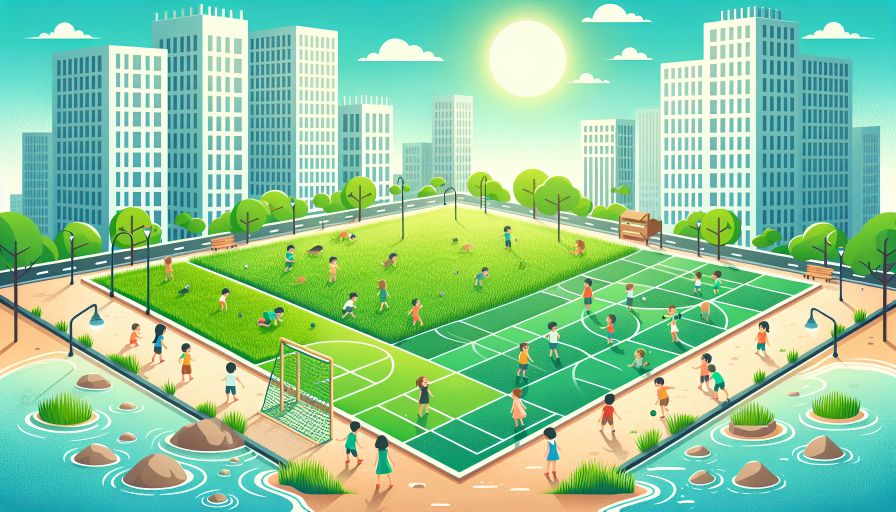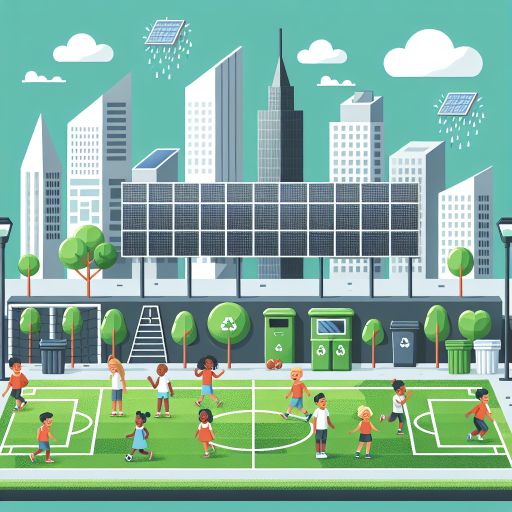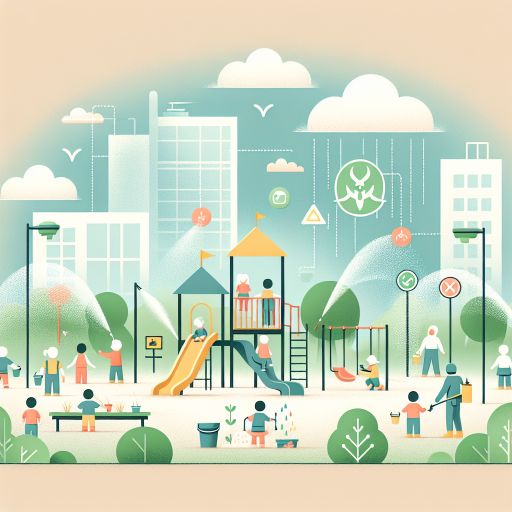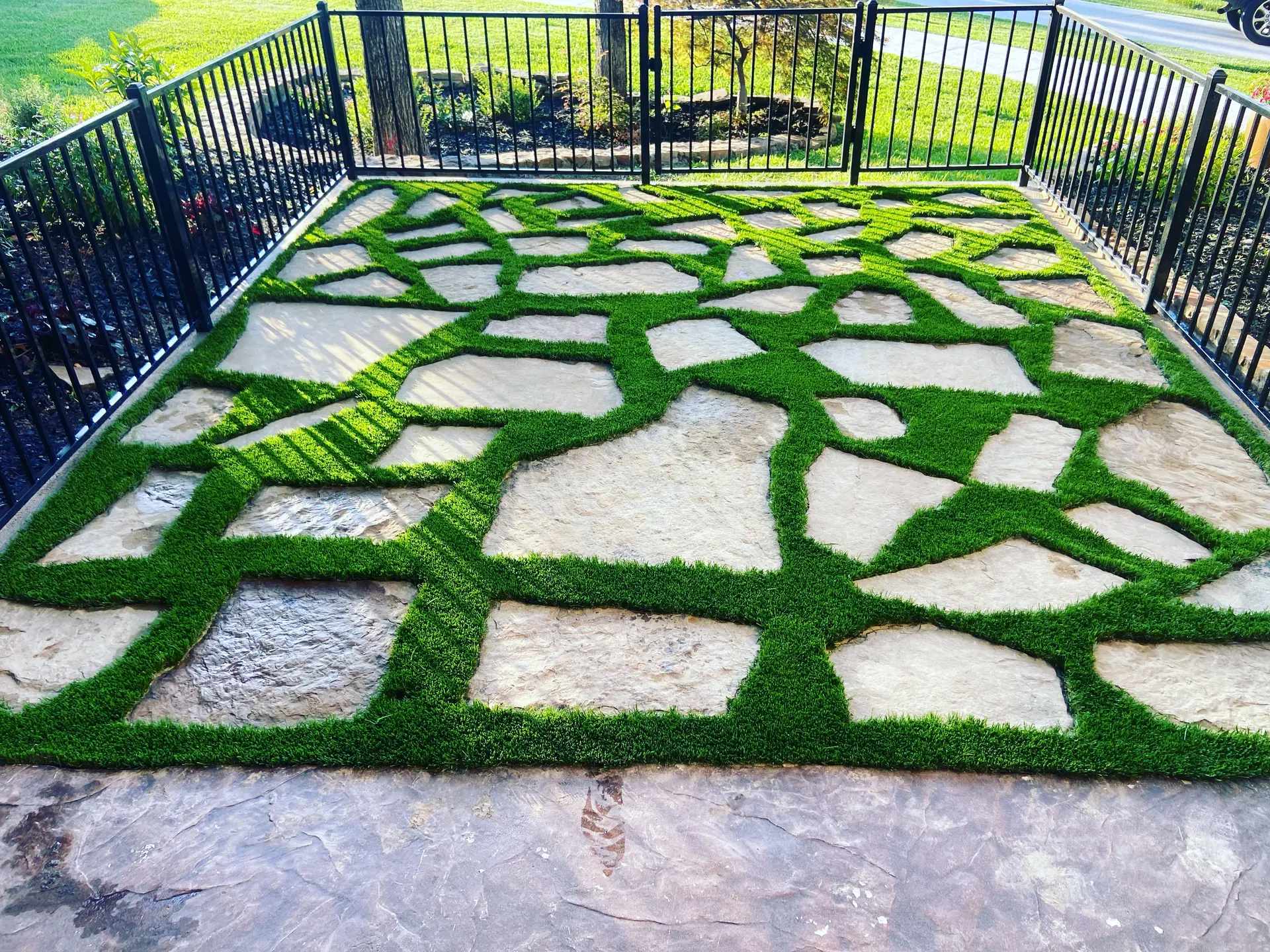
- Introduction to Synthetic Turf and Eco-Friendly Urban Play Areas
- Environmental Impact: Raw Materials and Manufacturing Process
- Water Conservation and Management Benefits of Synthetic Turf
- Reduction of Chemical Usage in Urban Play Areas
- Long-Term Durability and Maintenance of Synthetic Turf
- Heat Island Effect and Synthetic Turf Solutions
- Case Studies: Real-World Applications and Outcomes
- Future Trends and Innovations in Eco-Friendly Urban Landscapes
Introduction to Synthetic Turf and Eco-Friendly Urban Play Areas
Synthetic turf, often referred to as artificial grass, has gained substantial attention in recent years as a viable alternative to natural grass in urban play areas. This innovation is driven by the need for sustainable, low-maintenance solutions that can meet the demands of urban environments while minimizing environmental impact.
Synthetic turf systems are composed of various synthetic fibers that mimic the appearance and feel of natural grass. These fibers are typically made from materials such as polyethylene, polypropylene, or nylon. The backing system, which provides stability and durability, is often constructed from materials like latex or polyurethane. An infill material, which can be sand, crumb rubber, or organic alternatives, is used to enhance cushioning, support, and resilience.
Implementing synthetic turf in urban play areas can offer several potential advantages. These include reduced water usage, decreased dependency on chemical treatments, and lower maintenance requirements compared to natural grass. Additionally, synthetic turf can provide consistent use conditions year-round, bypassing the issues of mud, dust, and inconsistent grass coverage associated with natural lawns.
However, the consideration of synthetic turf in eco-friendly urban play areas extends beyond these immediate benefits. The environmental impact of raw materials, the manufacturing process, and end-of-life disposal or recycling of synthetic turf components must be evaluated to ensure a comprehensive understanding of its sustainability. By considering such factors, urban planners, developers, and community stakeholders can make informed decisions about the integration of synthetic turf in their projects. This overview seeks to examine the ecological footprint, water conservation benefits, maintenance reduction, and other environmental impacts associated with synthetic turf, thus providing a foundational understanding of its role in modern urban eco-friendly play areas.
Environmental Impact: Raw Materials and Manufacturing Process
Synthetic turf is produced using a variety of raw materials, primarily polyethylene, polypropylene, and nylon. These materials are derived from petroleum, necessitating the extraction and processing of fossil fuels. The environmental impact of these initial stages includes greenhouse gas emissions, energy consumption, and potential spills or accidents during extraction.
The manufacturing process of synthetic turf involves several steps: extrusion, tufting, coating, and finishing. During extrusion, raw plastic granules are melted and formed into fibers. In the tufting stage, these fibers are stitched into a backing material to create the turf’s basic structure. Coating then binds the fibers to the backing, and finishing processes refine the product for its final use.
Throughout these stages, energy and water consumption are significant factors. For example, extrusion and coating require substantial heat, generally generated from natural gas or electricity. The finishing process might include washing the turf, further contributing to water use. However, advancements in manufacturing technologies are aiming to reduce these impacts through energy-efficient machinery and water recycling systems.
Waste generation is another concern in the production of synthetic turf. Scraps and offcuts produced during manufacturing can contribute to landfill waste if not properly managed. Some manufacturers are implementing recycling programs to reprocess these materials back into the production cycle, thus reducing their environmental footprint.
The following table outlines key environmental impacts associated with the raw materials and manufacturing processes of synthetic turf:
| Aspect | Environmental Impact |
|---|---|
| Raw Material Extraction | Greenhouse gas emissions, habitat disruption, resource depletion |
| Manufacturing | Energy consumption, water use, waste generation |
| Post-Production | Waste management, potential recycling |
While the initial environmental impacts of synthetic turf production are notable, it is essential to balance these against the potential long-term benefits. These include reduced water use, elimination of pesticides and fertilizers, and lower maintenance-associated fuel emissions. Future advancements and increasing adoption of recycling practices could further mitigate the negative impacts, making synthetic turf a viable eco-friendly option for urban play areas.
Water Conservation and Management Benefits of Synthetic Turf
One of the most prominent benefits of synthetic turf in urban play areas is its significant contribution to water conservation and management. Unlike natural grass, synthetic turf does not require regular watering, which can lead to substantial water savings, especially in arid and drought-prone regions.
A study conducted by the Water Resources Research journal highlights that an average-sized sports field with natural grass can consume up to 500,000 gallons of water annually. By replacing natural grass with synthetic turf, these water requirements can be entirely eliminated. According to the Southern Nevada Water Authority, converting to synthetic turf can lead to water savings of 55 gallons per square foot per year.
Additionally, the use of synthetic turf can aid in stormwater management. Traditional grass fields often contribute to water runoff during heavy rains, which can lead to erosion and the contamination of waterways with fertilizers and pesticides. Synthetic turf systems, on the other hand, are typically installed with efficient drainage systems that help to control water flow and reduce runoff.
Incorporating porous underlays and drainage cells beneath synthetic turf allows rainwater to percolate through the surface and be directed to appropriate channels. This process not only helps in effective water management but also mitigates the risk of flooding in urban areas. The National Research Council of Canada has found that synthetic turf installations can reduce surface runoff by as much as 95% compared to conventional grass fields.
The water conservation benefits of synthetic turf are further supported by reductions in the need for irrigation infrastructure. Eliminating the need for extensive sprinkler systems reduces both the energy required to operate these systems and the costs associated with maintaining them. As a result, urban play areas with synthetic turf can achieve improved sustainability while also enjoying lower operating expenses.
Overall, the adoption of synthetic turf in urban play areas represents a practical and effective strategy for water conservation and management, particularly in regions facing water scarcity challenges. By significantly reducing water consumption and improving stormwater management, synthetic turf contributes to more resilient and environmentally conscious urban landscapes.
Reduction of Chemical Usage in Urban Play Areas
One of the most significant advantages of synthetic turf in urban play areas is the substantial reduction in the use of chemicals. Traditional grass lawns typically require pesticides, herbicides, and fertilizers to maintain their health and appearance. These chemicals can seep into the soil and waterways, contributing to pollution and posing risks to both human health and the environment.
Synthetic turf eliminates the need for such chemical treatments. Since it is composed of synthetic materials like polyethylene, polypropylene, or nylon, these turfs are inherently resistant to pests and do not require pesticides or insecticides. This results in a cleaner and safer environment for children and adults alike. Additionally, synthetic turf does not support the growth of weeds, thereby eliminating the need for herbicides.
Fertilizer usage is another area where synthetic turf shows its environmental benefits. Natural grass fields need fertilizers to replenish nutrients and maintain lush, green conditions. These fertilizers often contain nitrogen and phosphorus, which can lead to nutrient runoff. This runoff can impact local water bodies, leading to issues such as algal blooms that deplete oxygen levels and harm aquatic ecosystems. By switching to synthetic turf, urban play areas can avoid these negative environmental impacts.
It’s important to note that synthetic turf is not entirely free of maintenance chemicals. Occasionally, biocides and antimicrobial products are used to prevent bacterial and fungal growth, especially in high-traffic areas. However, the quantity and frequency of such treatments are generally much lower compared to the maintenance of natural grass.
In summary, the adoption of synthetic turf in urban play areas significantly reduces the reliance on harmful chemical treatments. By eliminating the need for pesticides, herbicides, and fertilizers, synthetic turf promotes a healthier and safer environment while also easing the burden on local ecosystems.
Long-Term Durability and Maintenance of Synthetic Turf
The long-term durability and maintenance of synthetic turf are critical factors in considering its environmental and economic impact. Compared to natural grass, synthetic turf offers significant advantages in terms of lifespan, ease of upkeep, and resource consumption.
Durability of Synthetic Turf
Synthetic turf is designed to withstand heavy use and adverse weather conditions, making it suitable for urban play areas. The materials used in modern synthetic turf, such as polyethylene, polypropylene, and nylon, contribute to its resilience. Tests have shown that high-quality synthetic turf can last between 8 to 15 years, depending on usage and maintenance practices.
Maintenance Requirements
Maintenance of synthetic turf is straightforward and requires fewer resources compared to natural grass. Regular sweeping, occasional brushing, and infill top-ups are generally sufficient to keep the turf in good condition. This ease of maintenance translates to lower labor and maintenance costs over the lifespan of the turf.
- Sweeping: Removes debris, leaves, and litter.
- Brushing: Keeps the fibers upright and ensures consistent appearance.
- Infill Top-Ups: Maintains surface stability and cushioning.
Cost and Resource Comparison
The initial installation cost of synthetic turf is higher than that of natural grass. However, the lower maintenance expenses and reduced need for water, fertilizers, and pesticides result in cost savings over time. These aspects make synthetic turf a viable long-term investment for urban play areas.
| Aspect | Synthetic Turf |
|---|---|
| Water Usage | Minimal |
| Fertilizer/Pesticide Use | None |
| Annual Maintenance Cost | Lower |
| Expected Lifespan | 8-15 Years |
Environmental Advantages and Considerations
From an environmental perspective, the durability and low maintenance requirements of synthetic turf contribute to its sustainability. Reduced water consumption and elimination of chemical treatments minimize its ecological footprint. However, end-of-life disposal remains an area needing attention, as improper disposal can lead to environmental pollution. Recycling initiatives are being developed to address this issue and enhance the eco-friendliness of synthetic turf systems.
In conclusion, the long-term durability and maintenance advantages of synthetic turf make it a cost-effective and environmentally beneficial solution for urban play areas. By understanding its lifecycle and maintenance needs, stakeholders can make informed decisions that foster both economic and ecological well-being.
Heat Island Effect and Synthetic Turf Solutions
The heat island effect is a significant environmental concern in urban areas, characterized by higher temperatures in cities compared to their rural surroundings. This phenomenon is primarily caused by human activities, including the concentration of buildings, pavement, and other infrastructure that absorbs and retains heat. Synthetic turf, while offering numerous benefits for urban play areas, has also been scrutinized for its contribution to the heat island effect.
Understanding the Heat Island Effect
The heat island effect results in increased ambient temperatures in urban settings, leading to heightened energy consumption, elevated emissions of air pollutants and greenhouse gases, and impaired human health and comfort. Research indicates that urban areas can experience temperatures up to 7°C (13°F) higher than nearby rural areas.
Synthetic Turf and Surface Temperatures
Studies have revealed that synthetic turf can reach temperatures significantly higher than natural grass. For instance, surface temperatures of synthetic turf fields can exceed 60°C (140°F) under direct sunlight. This is due to the materials used in synthetic turf, such as rubber infill and plastic blades, which absorb and retain heat more than natural grass. Research has highlighted the need for additional measures to mitigate high surface temperatures on synthetic turf fields.
Mitigation Strategies
Several strategies have been developed and implemented to reduce the heat retention of synthetic turf surfaces:
- Cooler Infill Materials: Manufacturers have introduced alternative infill materials, such as coated sand or organic infills, which reduce heat absorption.
- Watering Systems: Some synthetic turf fields are equipped with irrigation systems to cool the surface by spraying water at regular intervals.
- Reflective Coatings: Surface treatments and reflective coatings are applied to synthetic turf to enhance its reflectivity and decrease heat absorption.
- Shade Structures: Installing shade structures or incorporating nearby vegetation can provide cover, effectively lowering surface temperatures.
Scientific Studies and Data
Empirical data from various studies supports the effectiveness of these strategies. For example, research conducted at Brigham Young University found that synthetic turf surfaces treated with a reflective coating had temperatures approximately 15-20°C (27-36°F) lower than untreated surfaces. Additionally, the utilization of organic infill was shown to reduce surface temperatures by up to 30% compared to traditional rubber infill.
Conclusion
While synthetic turf can contribute to the urban heat island effect due to its higher surface temperatures, there are effective strategies available to mitigate this impact. Utilizing alternative infill materials, reflective coatings, watering systems, and providing shade can significantly reduce the heat retention of synthetic turf, making it a more eco-friendly solution for urban play areas. Continuous research and innovation are essential to further improve these methods and enhance the sustainability of synthetic turf in urban environments.
Case Studies: Real-World Applications and Outcomes
At Prime Design Turf, the transformative potential of synthetic turf in urban play areas is not just a theoretical priority but a practical reality. With over 20 years of industry experience, the company has successfully implemented projects that demonstrate both environmental benefits and community enhancement.
In urban spaces, where green areas are often limited, synthetic turf offers a sustainable alternative to natural grass. These installations are designed to withstand heavy use and require minimal upkeep, making them a cost-effective and environmentally friendly solution. Beyond aesthetics, these applications contribute to significant water savings, reduced chemical use, and the creation of safer play environments for children and pets.
Prime Design Turf’s synthetic turf products have proven exceptionally beneficial in various real-world scenarios:
- Home Gardens and Landscape Turfs: These installations enhance the visual appeal of residential spaces while saving water and reducing the need for chemical fertilizers and pesticides.
- Backyard Putting Greens: These custom-designed turfs offer a recreational area for homeowners without the high maintenance demands of natural grass.
- Pet-Friendly Zones: Synthetic turf in these areas eliminates the risk of exposure to toxic chemicals for pets, providing a safe and clean environment.
- Parks and Playgrounds: The use of synthetic turf in urban parks and playgrounds ensures durability and safety, minimizing the risk of injuries from hard surfaces.
- Sports Fields: Synthetic grass fields offer a resilient playing surface that holds up under heavy use, reducing the need for frequent repairs and upkeep.
| Project Type | Environmental Impact |
|---|---|
| Home Gardens | Decreased water usage and reduced chemical runoff |
| Urban Playgrounds | Enhanced safety and durability, lower maintenance costs |
| Sports Fields | High resilience, minimal natural resource consumption |
Emphasizing a blend of creative design and meticulous installation, Prime Design Turf has established itself as a leading provider in transforming urban play areas into environmentally sustainable and visually appealing spaces. These projects stand as testimonies to the practical benefits of synthetic turf, aligning with eco-friendly goals and enhancing urban living experiences.
Future Trends and Innovations in Eco-Friendly Urban Landscapes
The development and implementation of synthetic turf in urban play areas are evolving rapidly, driven by technological advancements and a growing awareness of environmental sustainability. Future trends and innovations are poised to further enhance the eco-friendliness and functionality of synthetic turf.
One significant trend is the integration of recyclable materials in the production of synthetic turf. Manufacturers are increasingly using components that can be reused or recycled at the end of their life cycle, which helps minimize waste. For example, some turf systems now incorporate recyclable backing materials and plant-based infill options, contributing to a more circular economy.
Another area of innovation is the improvement of the heat reduction capabilities of synthetic turf. Researchers and companies are exploring advanced cooling technologies to mitigate heat island effects. Some of these include the use of reflective pigments and materials that enhance heat dissipation, keeping the surface temperature lower and more comfortable for urban play areas.
Water management solutions are also becoming more sophisticated. Innovative drainage systems are being designed to manage heavy rainfall and reduce runoff, which can prevent flooding and waterlogging in urban environments. Enhanced permeability allows water to pass through the turf efficiently, promoting better groundwater recharge and reducing the burden on stormwater infrastructure.
The development of antimicrobial treatments for synthetic turf is another promising innovation. These treatments can help prevent the growth of harmful bacteria and fungi, thereby maintaining safer and more hygienic play surfaces. This development is particularly crucial for areas with heavy use, such as schools and public parks, where the risk of microbial contamination is higher.
Finally, advancements in manufacturing processes are leading to synthetic turfs with longer lifespans and lower maintenance requirements. Innovations such as more resilient fibers and improved UV resistance mean that turf can maintain its appearance and functionality over extended periods. This reduces the need for frequent replacements and lowers the overall environmental footprint associated with production and disposal.
In conclusion, the future of synthetic turf in urban play areas looks promising, with continuous innovations driving towards more sustainable, efficient, and user-friendly solutions. As these technologies and materials evolve, they will likely play an increasingly vital role in creating eco-friendly urban environments.



